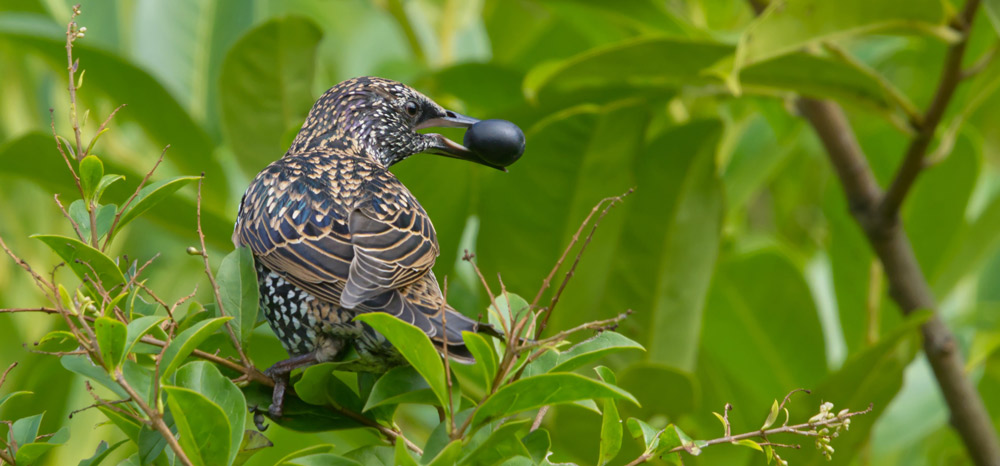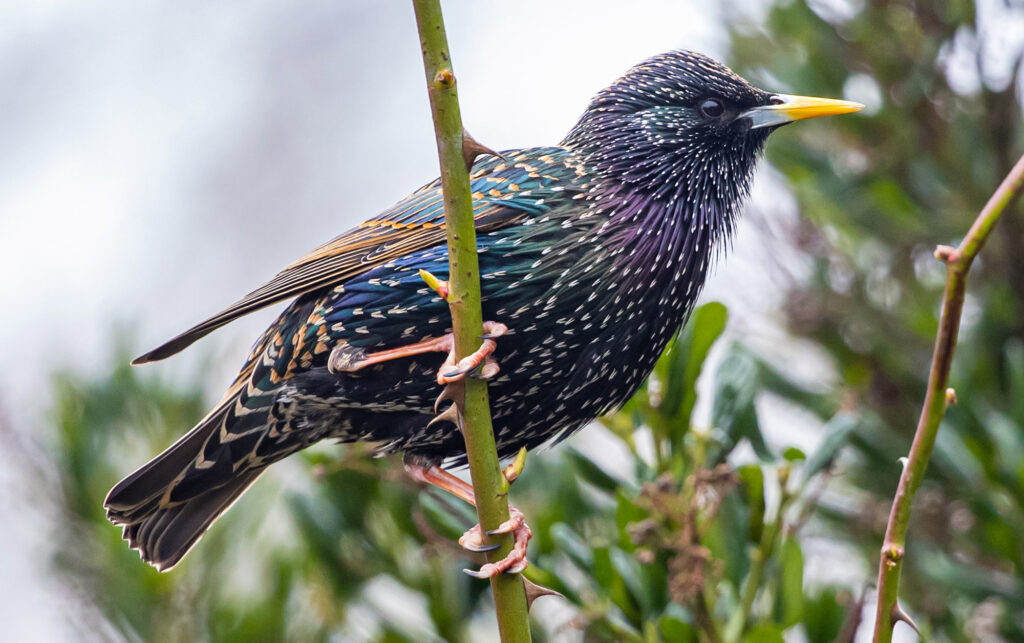COMMON STARLING, SONG, HABITAT, SOUND, VIDEOS, INVASIVE, ORIGIN, DIET

The Common Starling (Sturnus vulgaris) or European Starling is a bird species native to Europe, Asia, and Africa but has been introduced to several other regions of the world, including North America.
CHARACTERISTICS
To begin with, the species is well-known for its black glossy plumage, distinctive iridescent feathers, and complex vocalizations.
DIET
European Starlings are omnivores and feed on a wide variety of food items such as insects, fruits, seeds, and human-made food. This adaptability to different food sources has allowed them to thrive in various habitats, from urban areas to agricultural lands.
FLOCKING BEHAVIOR
Also, one of the most notable features of the Common Starling is its flocking behavior.
In the winter, they often form large flocks that can number in the thousands, creating impressive aerial displays as they move in synchrony. This behavior not only provides protection against predators but also allows the birds to efficiently find food.
CHALLENGES
Despite their widespread distribution and abundance, the Common Starling has faced challenges in recent decades. In some regions, populations have declined due to habitat loss and degradation, pesticide use, and other human activities.
To add more, the species is known to carry diseases that can affect both wild and domestic birds, posing a threat to biodiversity.

CONSERVATION EFFORTS
To pursue, conservation efforts to protect the Common Starling and its habitats have been undertaken in several regions.
These include measures to reduce pesticide use, restore degraded habitats, and control the spread of diseases. In addition, some countries have implemented regulations to prevent the introduction of non-native bird species that may compete with or harm the Common Starling.
INTELLIGENT
As a matter of fact, the European Starling is known for its intelligence and problem-solving abilities.
Studies have shown that the bird can use tools, recognize, and remember human faces, and adapt to new challenges. Indeed, these traits make the Common Starling a popular subject for animal behavior research and provide insight into the cognitive abilities of birds.

SOUND
Another unique aspect of the Common Starling is its vocal repertoire. The bird can produce a wide range of sounds and has a complex language system that allows it to communicate with other birds.
Additionally, the species is known for its ability to mimic other bird species and human speech, making it a popular pet in some cultures.
CAUSING PROBLEMS
Regardless of its intelligence and ability to adapt to new environments, the Common Starling has also caused problems in some regions.
The species is known to compete with native bird species for food and nesting sites, leading to declines in local populations. In addition, the bird is a notorious agricultural pest, causing damage to crop and reducing yields.
CONTROL OF POPULATION
Considering these challenges, some countries have implemented measures to control the population of Common Starlings, including culling and habitat management programs.
However, these measures have been controversial and have sparked debate among conservationists and animal welfare advocates.

SYMBOL
It is also important to remember that the Common Starling is not just a bird, but also a symbol of the impact humans have on the environment.
Its introduction to new regions highlights the unintended consequences of human activities, such as the introduction of non-native species, and the importance of considering the long-term impacts of our actions.
By working to protect the Common Starling and other wildlife, we can help ensure the health and diversity of the ecosystems we depend on.
INSPIRATION
Yet, the Common Starling can serve as an inspiration for environmental education and public outreach. Its ability to adapt and thrive in urban environments provides opportunities to engage with the public and promote awareness of the importance of preserving wildlife and habitats.
It’s by highlighting the unique qualities and challenges faced by this species, we can inspire people to take action to protect the natural world and promote sustainable practices.

SCIENTIFIC RESEARCH
Furthermore, the Common Starling can also serve as a valuable tool for scientific research. Studying the biology, behavior, and ecology of this species can provide important insights into the functioning of ecosystems and the processes that drive biodiversity.
For instance, this information can then be used to develop more effective conservation and management strategies for other wildlife and habitats.
CULTURAL SIGNIFICANCE
This bird has a rich cultural significance in many societies. In literature and art, it has often been portrayed as a symbol of freedom, beauty, and resilience.
The species has inspired poets, musicians, and artists, who have celebrated its unique qualities and used it as a metaphor for human experiences and emotions.

ECOSYSTEM INDICATOR
It is also worth mentioning that the Common Starling is an important indicator of the health of ecosystems and the environment.
Changes in its population size, behavior, or distribution can indicate broader environmental changes, such as climate change or habitat loss.
Monitoring the status and trends of the Common Starling can provide early warnings of potential threats to other wildlife and habitats, allowing us to take proactive measures to conserve and protect them.
In conclusion, the Common Starling is a species of great scientific, cultural, and environmental significance. Its unique biology, behavior, and cultural significance make it a valuable subject of study, while its role as an indicator of environmental health highlights the importance of preserving its habitats and populations. By continuing to study and appreciate the Common Starling, we can gain a deeper understanding of the natural world and our place in it and take action to protect it for future generations.
WANT TO LEARN MORE? TAKE A LOOK AT THESE ARTICLES:
- The Scarlet Macaw
- The Scarlet Ibis
- Lovebirds
- The Female Cardinal
- The Great Egret
- The Great Blue Heron
- The American Robin
- The Northern Cardinal
- The Dark-Eyed Junco
- The Blue Jay
- The Gray Catbird
- The Tufted Titmouse
- The Red-winged Blackbird
- The Black-capped Chickadee
- The Evening Grosbeak
- The Common Starling
- The Kiwi Bird
- Wild Birds Unlimited

